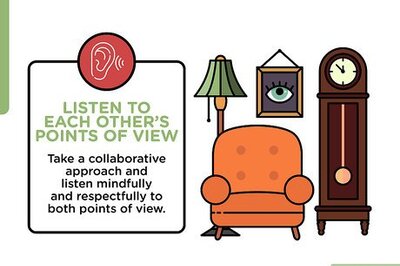
views
At the time when GPS was used only for military purposes, one technologist in Silicon Valley envisioned it as a mass product for consumers. He then went on to make it readily available for the everyday usage of people across the globe.Kanwar Chadha, popularly known as Mr GPS, talks about his journey in an exclusive interview with News18.com. Read how the entrepreneur, technologist and visionary brought GPS to your smartphones.Q: What brought on the idea of GPS as a mass product?A: When we started SiRF, I realised that although the GPS technology was present, its usage was only limited to defence or other high-end applications. I inherently felt that location is going to have a major impact on the day to day users and nobody was really working on the consumerization of GPS.
Coming from a Silicon Valley background (Kanwar used to work at Intel), I felt that if we can integrate all the elements of GPS processing in small chips, then we can achieve a breakthrough in terms of the cost, power and solve some of the problems people were having, with GPS.
It seemed a very interesting challenge at the time. If we could solve that problem, then GPS would surely have become a part of people’s everyday lives. Q: Did you have any Plan of Action for this?A: When we started thinking about GPS, we came up with an ‘Idea Book’ that looked into how GPS can be embedded into people’s lives. We were looking at it as a horizontal market instead of vertical, so we started looking at the problems which people face in the mobile environment.
The first was obviously ‘Navigation’. The navigation systems were very expensive and were fixed in the car. So we worked upon making it portable and at a lower cost. We created a platform which enabled the Portable Navigation Market.
We also started to ponder how to embed this technology into phones. The first idea was focussed on how to build on Geotags. At that time, I was thinking of it as an emergency response for people so they could get immediate help at the push of a button in times of emergency.
The idea was to enable location as a core attribute so that other applications like Navigation, emergency response, searches could be built upon that. Q: What is SiRF Technology? Where all is it used?A: SiRF was all about putting location or GPS into small chips and also licensing the technology so it could be integrated into different mobile platforms. Then we merged SiRF with CSR which had Bluetooth and Wi-Fi Technology. Using this, we could combine location with wireless connectivity.
SiRF technology is now a part of Qualcomm. We also licensed the technology to Samsung which is integrating it into the mobile phones. The whole idea was focussed on the mass market and not to a dedicated professional usage.Q: You came up with another startup named Inovi Inc. What was that about?A: After SiRF was sold to Qualcomm, me and my co-founder from SiRF, founded a new company which was focussed on wireless broadband. We felt that in the absence of Fibre infrastructure in most of the places, it was much quicker and cost-efficient to extend the connectivity wirelessly.
The challenge was how to get the bandwidth that Fibre could provide, in a wireless way. So we started using millimetre waves, which are very high-frequency waves, to create what I call ‘wireless fibre-equivalent’.
The company was later on taken over by Facebook. Facebook is now deploying the technology to create an open platform which will provide gigabytes of bandwidth anywhere at a much cheaper cost.Q: How is it different from Facebook’s satellite connectivity?A: Satellite is more focused on areas with remote connectivity while our technology, called ‘Teragraph’, is focussed on urban/ high-density connectivity where people need high bandwidth.Q: What are the present projects that you are working on?A: Now I’m working on ‘Internet of Things’ technology for consumer space. Even in IoT, location plays a crucial part. We are looking at how to bring cloud connectivity and services to day to day consumer lives. It brings the three core elements together: Location, Cloud and the device itself.Q: How do you ensure the security of the data transferred over the cloud?A: We ran into security issues with GPS too. The data transferred over the cloud is very sensitive and should not be compromised. Security for such information should be in multiple layers.
First of all, the data should never go raw, it should always be encrypted.
Second, the devices should be secured as well. Password protection and other protection measures should be embedded into the device.
The link between the device and the cloud needs to be secured as much as the cloud.
At the cloud level, you have the aggregation of data and that is the most dangerous place to be hacked. As Cloud combines multiple data streams, it needs to be the most secure platform in the entire IoT ecosystem.Q: You mentioned that the devices need to be secured. Are there enough mandates in place to ensure that?A: In the early stage, it was like the Wild West, as people started experimenting with IoT without realising the security and privacy implications. I think the next generation will be a lot more careful.
Recently many cases of hacking came up and now the US regulatory people have started to go after the companies which do not put the necessary security elements into their devices.
Today IoT is in the hyped phase. The subsequent generations will be able to make it more robust in terms of security and the services.Q: How is it different from the security implications for the defence sector?A: There has to be a separation between the Consumer Spectrum and the Defence spectrum.
Consumer spectrum adds the leverage of making things cost-efficient but that alone does not solve the purpose for defence. Security becomes a significant value-add which you have to create on top of that.Q: How does India rank amongst the GPS infrastructure?A: India is one of the few countries having systems which complement GPS. Europe, Russia, China and Japan are the only other countries in this segment.
Since GPS cannot be optimised for every region, complementing it with your own technology can really optimise it for a particular area.
India is quite advanced in these terms as it has a good satellite technology and a good understanding of the usage of location and navigation.
The challenge for India is that, though we have the scientific knowledge, we are yet to have the mainstream deployment or commercialization of such technology.
e.g. for IoT, broadband connectivity is a crucial factor in which India lacks. I feel it’s a deployment problem.
The good part is that India can leapfrog a generation using the already developed technology around the world. India has gone ‘mobile’ but has not gone ‘broadband’ as yet. To go ‘broadband’ India can skip the part of laying down wires now and directly jump to ‘Wireless connectivity’.
I believe India is now ready to lead the world in terms of technology instead of just following the way.Q: Having achieved so many accomplishments, what are you most proud of?A: The thing that I am most proud of is that we came out with a vision of GPS at the time when nobody really believed in it. Today, I see my daughters who take location based technology for granted. The fact that now everybody uses GPS in their daily lives really makes me proud.Also read: 250 Years of SoI With Surveyor General of India

















Comments
0 comment